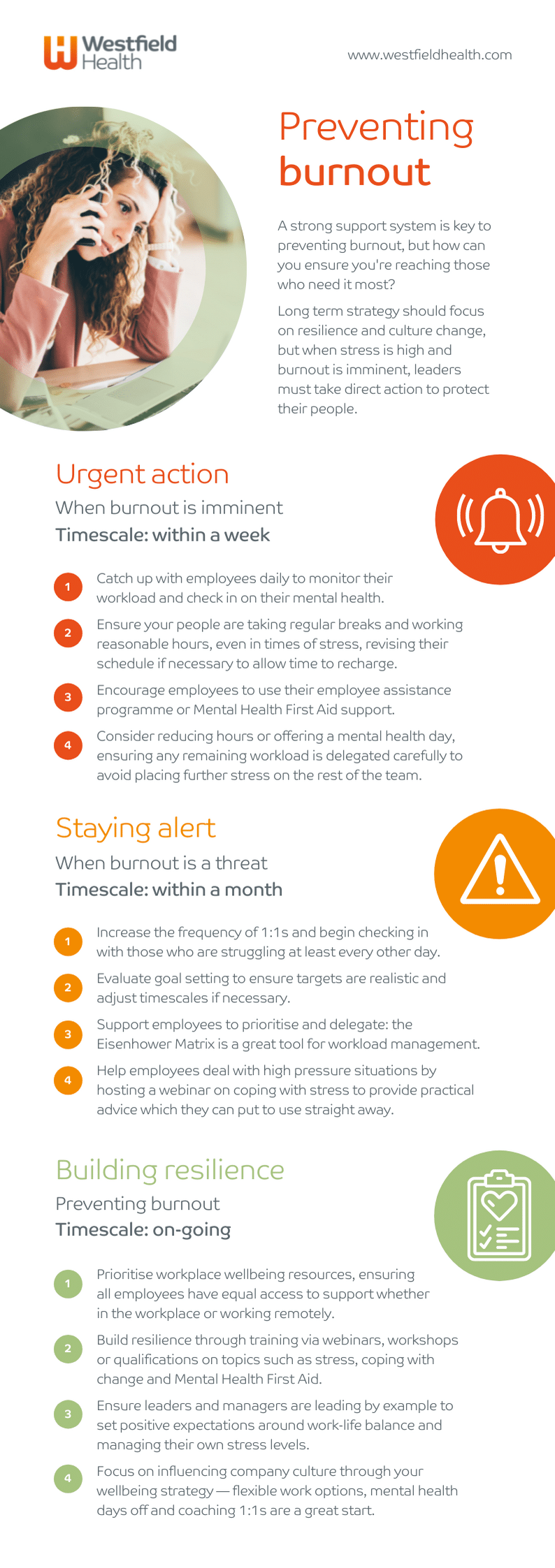While workplace stress is nothing new, factors outside our control are increasingly taking a toll on workers’ mental health. According to our latest workplace wellbeing research, one in three UK workers (30%) say feeling burnt out has affected their mental health in the past year.
However, the issues causing burnout reach far beyond the working day: almost 9 in 10 people (86%) say external factors had an impact on their mental health in 2023. Across the country, people are in survival mode, feeling under constant strain as they struggle to manage not only their workloads, but also external factors such as personal finance, conflict and climate change.
In this blog, we share our tips for how managers can support their people through times of stress to help prevent employee burnout.
Strategies for preventing burnout
Working on the brink of burnout has a significant mental health impact not only on individuals but on the workforce as a whole. Almost half of people (45%) said their mental health has impacted their productivity in the past year, creating additional pressure for managers as their teams become fractured by exhaustion and low morale.
And with 40% of UK workers considering a job change in the next year, businesses need to support employee wellbeing or risk losing out on top talent due to stress.
Your mental health strategy will depend on how burnout is impacting your team and how imminent the threat is. Speaking to your people is the first step to assessing the situation, and people managers are often best placed to have these conversations.
Long-term strategy should focus on resilience and culture change, but when stress is high throughout an organisation, managers must step in to protect their teams from burnout.
What to do when burnout is imminent
Managers can look out for signs that may indicate burnout is imminent, including employees booking last-minute days off, working at odd hours or skipping meetings. Starting the conversation can be difficult, but a direct approach is best.
If employees are struggling with stress and burnout is less than a week away, it’s time to take urgent action. By this stage, burnout is likely to be impacting multiple employees and causing low morale across the whole team.
These practical solutions can help ease the pressure while managers resolve any underlying capacity or workload issues:
- Catch up with employees daily to monitor their workload and check in on their mental health.
- Ensure people are taking regular breaks and working reasonable hours, even in times of stress, revising employee schedules if necessary to allow time to recharge.
- Encourage workers to use their employee assistance programme or Mental Health First Aid support.
- Consider reducing hours or offering a mental health day, ensuring any remaining workload is delegated carefully to avoid placing further stress on the rest of the team.
Handling high-pressure situations to prevent burnout
Everyone experiences times of stress: a short deadline, a complex project or an unexpected assignment can increase the pressure across the whole team. Dealing with these situations effectively helps your people feel supported and prevents stress from turning into mass burnout.
If employees are feeling the strain, a combination of immediate and preventative measures can give them the tools to cope:
- Increase the frequency of 1:1s and begin checking in with those who are struggling at least every other day.
- Evaluate goal setting to ensure targets are realistic and adjust timescales if necessary.
- Support employees to prioritise and delegate: the Eisenhower Matrix is a great tool for workload management.
- Help employees deal with high pressure situations by hosting a webinar on coping with stress to provide practical advice which they can put to use straight away.
Long-term burnout prevention
Of course, the best way to protect employee mental health is to prevent situations where burnout may occur. While this often requires a significant shift in company culture, managers can build resilience in their teams to help their people build healthy workplace habits.
Your burnout prevention strategy should be an on-going project with goals and milestones to monitor its success. A few changes to your day-to-day can help get you started:
- Prioritise workplace wellbeing resources, ensuring all employees have equal access to support whether in the workplace or working remotely.
- Build resilience through training via webinars, workshops or qualifications on topics such as stress, coping with change and Mental Health First Aid.
- Ensure leaders and managers are leading by example to set positive expectations around work-life balance and managing their own stress levels.
- Focus on influencing company culture through your wellbeing strategy — flexible work options, mental health days off and coaching 1:1s are a great start.
Free resources and downloads
Our traffic light guide can help you choose the best approach for preventing burnout and summarises all the tips in this blog to help you step in when employees are struggling.
Download this information as an infographic or PDF to share with your team.
